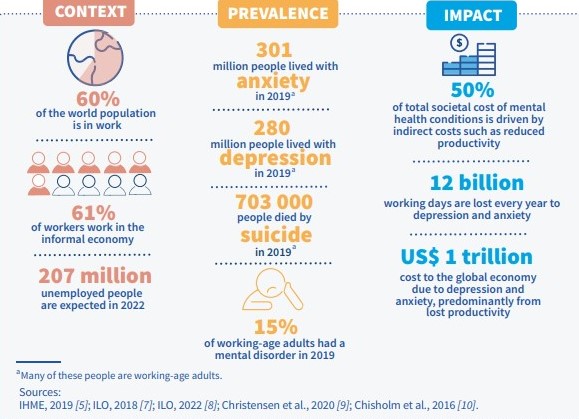WHO/ILO: How to address mental health at work
A joint policy brief from WHO and ILO calls for global action to combat mental health at work. The brief illustrates practical strategies for governments, employers, workers and their organizations in the public and private sectors.
TThe report focuses on preventing psychosocial risks, protecting and promoting mental health, and supporting workers with mental illness to participate and thrive in the world of work.
It is said that an estimated 12 billion work days are lost each year to depression and anxiety, costing the global economy nearly $1 trillion. The WHO global guidelines on mental health at work recommend actions to address mental health risks such as heavy workloads, negative behavior and other factors that cause stress at work. For the first time, WHO is recommending manager training to build their ability to prevent stressful work environments and respond to workers in distress.
It’s time to focus on the detrimental effects work can have on our mental health. Individual well-being is reason enough for action, but poor mental health can also negatively impact a person’s performance and productivity
said dr Tedros Adhanom Ghebreyesus, WHO Director-General.
 The need for action
The need for action
Effective strategies and measures to improve mental health at work are crucial to upholding the human right to good health, including mental health, and to progress towards the Sustainable Development Goals (SDGs), in particular SDG 3 on health and SDG 8 decent work, push forward all.
For individuals and households, better mental health in the workplace can reduce exclusion, improve overall health and well-being, and increase economic security. Firms also benefit from greater labor market participation and higher productivity, both of which improve a firm’s bottom line. For governments, too, addressing mental health in the workplace can result in savings in health care spending and social welfare.
The cost to society of inaction is significant. There is a cost associated with providing mental (or physical) health care. However, the indirect costs of reduced productivity (which can include premature death, disability and reduced productivity at work) often far outweigh the direct costs of care.
Improving mental health in the workplace requires action to prevent work-related mental illness, to protect and promote mental health in the workplace, and to support all workers to participate fully and equitably in work. Each strand of action is of limited value on its own and works best when implemented together with the others as part of a broad and comprehensive approach.
Stakeholders in the world of work can help create an enabling environment for change by securing commitment and resources, addressing stigma and discrimination, coordinating intersectoral and participatory approaches, and strengthening the evidence for effective interventions.
Mental health strategies in the workplace
#1 Prevent: Transform work environments to minimize psychosocial risks and prevent workers from experiencing mental illness.
#2 Protect and promote: Strengthening the awareness, skills and opportunities to identify and respond to mental health problems early in order to protect and promote the mental health of all workers.
#3 Support: Support workers with mental illness to access, keep going and thrive at work.
Individual interventions
Individual workplace interventions are delivered directly to a worker who then implements them with or without the guidance of a competent practitioner. These include psychosocial interventions and opportunities for leisure-based physical activity.
Psychosocial interventions use interpersonal or informal activities, techniques, or strategies to build stress management skills and reduce mental health symptoms. Examples are psychoeducation, stress management training (including relaxation training and mindfulness training), and emotional or practical social support. Evidence shows that these interventions can help promote positive mental health, reduce emotional distress, and improve work effectiveness.
Stress management interventions, including digital self-help tools, are a popular choice for employers because they can be easily made available to a workforce given the appropriate resources. However, they should only be undertaken as part of a broader program of activities that also includes other interventions aimed at preventing, protecting and promoting and supporting mental health in the workplace. This is because a focus on individual stress management alone is unlikely to be effective; Critically, when people experience understandable stress in response to difficult work circumstances, it can falsely make people feel like their own fault.
It is important for employers to review and verify the quality and effectiveness of any intervention before using it by seeking expert advice. Many digital psychological self-help applications are available and only a few are well tested and evaluated.
Workers with mental illness should also be offered (but not required) access to evidence-based psychological treatment, preferably outside the workplace. This may include behavioral activation, problem-solving therapy, cognitive behavioral therapy, or interpersonal therapy. Any provider of psychological treatment must be appropriately accredited and subject to clinical supervision.
LEARN MORE IN WHO/ILO’S REPORT ON MENTAL HEALTH AT WORK

